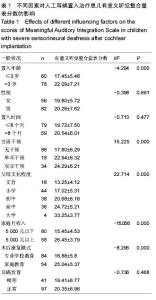| [1] 杨春秀,孙海波.感音神经性耳聋的治疗进展[J].中医耳鼻喉科学研究杂志,2012,11(9):39-42.
[2] 叶建军,姜艳丽,罗樱,等.感音神经性耳聋患儿和正常儿童内耳解剖径线MRI测量对比研究[J].中国医学影像学杂志, 2012,11(3):809-811.
[3] 中华医学会耳鼻喉科分会,中华医学会耳鼻喉科杂志编辑委员会.人工耳蜗植入工作指南(2003年,长沙)[S].中华耳鼻喉科杂志,2004,39(2):66-69.
[4] Robbins AM,Renshaw JJ,Berry SW.Evaluating meaningful auditory integration in profoundly hearing impaired children.Am J Otol.1991;12:144-150.
[5] Zimmerman-Phillips S,Robbins AM,Osberger MJ.Assessing cochlear implant benefit in very young children.Ann Otol Rhinol Larygol Suppl. 2000;185: 42-43.
[6] Nikolo Poulos TP,Aiehhold SM,DonoghueGM.Coch learing Plantation in children an emerging evidence base from Nottingham.ENT News.2001;10(1):37-38.
[7] 胡宁,曹永茂.人工耳蜗咨询问题解答[J].听力学及言语疾病杂志,2001,9(1):61-62.
[8] 吴海生,蔡来舟,田鸿.实用语言治疗学[M].北京:人民军医出版社,1995:57.
[9] Kileny PR,Zwolan TA,Ashbaugh C.The influence of age at implantation on performance with a cochlear implant in children.Otol Neurotol.2001;22:42.
[10] 冀飞,都听,洪梦迪,等.语前聋人工耳蜗植入患者听觉和言语康复效果的问卷分级评估[J].中华耳鼻咽喉杂志, 2004, 39(10):584-588.
[11] 李永新,韩德民,赵啸天,等.Mondini畸形多道人工耳蜗植入的效果分析[J].中华耳鼻咽喉科杂志, 2004,39(2):89-92.
[12] 陈新民,陈亚安.中国残疾儿童现状分析及对策研究[M].北京:华夏出版社,2008:160-161.
[13] 张惠荣,张庆龄,问明瑶.感应神经性耳聋患儿人工耳蜗植入围术期护理[J].护理学杂志, 2006,21(22):48-49.
[14] ShPherd RK,Dowell RC,Xu SA,et al.Multichannel Cochlear ilnplanti children.In yanagihara N,suzzuki J.Transplants And Implants In Otology III: Proceedings Of The Third International Symposium On Transplants And Implants In Otology. matsuyama, ehime,span, 1991,Amsterdam/new york:kugler publications,1992: 253-266.
[15] Galvin KL, Noble W.Adaptation of the speech, spatial, and qualities of hearing scale for use with children, parents, and teachers.Cochlear Implants Int. 2013; 14(3):135-141.
[16] Cullington H,Bele D,Brinton J,et al.United Kingdom national paediatric bilateral cochlear implant audit: preliminary results.Cochlear Implants Int.2013;14 Suppl 4:S22-26.
[17] Li W, Dai C, Li H, et al.Factors impacting early cochlear implantation in Chinese children.Eur Arch Otorhinolaryngol. 2016;273(1):87-92.
[18] Martines F,Martines E,Ballacchino A,et al.Speech perception outcomes after cochlear implantation in prelingually deaf infants: the Western Sicily experience.Int J Pediatr Otorhinolaryngol.2013;77:707.
[19] Ceh KM,Bervinchak DM,Francis HW.Early literacy gains in children with cochlear implants.Otol Neurotol. 2013;34:416.
[20] Beer J,Kronenberger WG,Castellanos I,et al.Executive functioning skills in preschool-age children with cochlear implants.Int J Speech Lang Hear Res. 2014; 57:1521.
[21] Vincenti V,Bacciu A,Guida M,et al.Pediatric cochlear implantation: an update.Ital J Pediatr.2014;40:72.
[22] Turgeon C,Champoux F,Lepore F,et al.Deficits in auditory frequency discrimination and speech recognition in cochlear implant users.Cochlear Implants Int.2015;16(2):88-94.
[23] Dean C,Felder G,Kim AH.Analysis of speech perception outcomes among patients receiving cochlear implants with auditory neuropathy spectrum disorder.Otol Neurotol. 2013;34(9):1610-1614.
[24] Illg A,Giourgas A,Kral A,et al.Speech comprehension in children and adolescents after sequential bilateral cochlear implantation with long interimplant interval. Otol Neurotol.2013;34(4):682-689.
[25] Wolfe J,Morais M,Schafer E,et al.Evaluation of speech recognition of cochlear implant recipients using a personal digital adaptive radio frequency system.J Am Acad Audiol.2013;24(8):714-724.
[26] Yoshida H,Takahashi H,Kanda Y,et al. Long term speech perception after cochlear implant in pediatric patients with GJB2 mutaions.Auris Nasus Larynx. 2013;40(5):435-439.
[27] Semenov YR,Yeh ST,Seshamani M,et al. Age-dependent cost-utility of pediatric pediatric cochlear implantation.Ear Hear.2013;34(4):402-412.
[28] Martini A,Bovo R,Trevisi P,et al.Cochlear implant in children:rational,indications and cost/efficacy.Minerva Pediatr.2013;65:325. |

